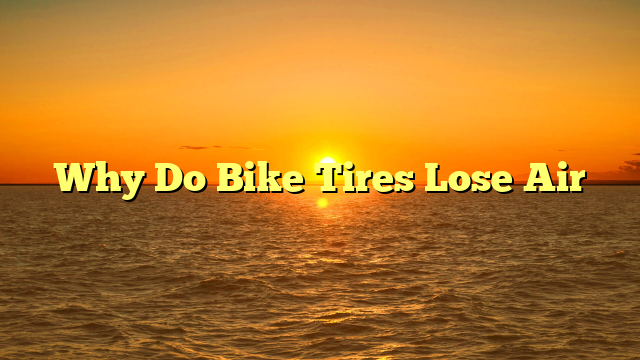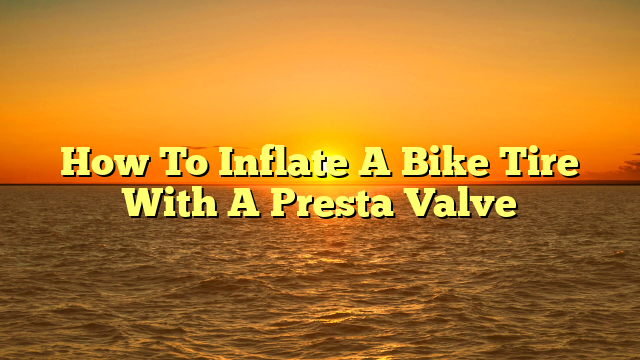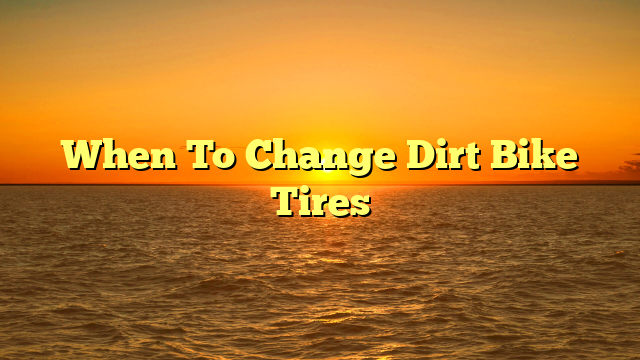Bike tires are an essential component of a bicycle’s performance and safety.
However, like any other mechanical equipment, bike tires are prone to losing air over time.
The gradual loss of air pressure in bike tires can lead to reduced performance, lower efficiency, and even safety hazards.
Many factors can contribute to the loss of air pressure in bike tires, ranging from natural air leakage to punctures, valve issues, temperature changes, improper installation, and wear and tear.
Understanding the reasons why bike tires lose air is crucial for any cyclist who wants to maintain optimal tire pressure and performance.
This article will delve into the various causes of air loss in bike tires, their effects on-bike performance, and practical tips for maintaining proper tire pressure.
By the end of this article, readers will have a comprehensive understanding of why bike tires lose air, how to detect air leaks, and how to prevent them from happening.
Table of Contents
- 1 Key Takeaways
- 2 Natural Air Leakage
- 3 Punctures from Sharp Objects
- 4 Valve Issues
- 5 Improper Installation
- 6 Temperature Changes
- 7 Wear and Tear
- 8 Tubeless Tire Sealing Issues
- 9 Tips for Maintaining Proper Tire Pressure
- 10 Frequently Asked Questions
- 10.1 Can using a tire sealant prevent natural air leakage in bike tires?
- 10.2 How can I prevent punctures from sharp objects while riding my bike?
- 10.3 What should I do if my valve stem is damaged or worn out?
- 10.4 Are there any specific techniques for properly installing bike tires to prevent air loss?
- 10.5 Is it common for tire pressure to fluctuate significantly due to temperature changes?
- 11 Conclusion
Key Takeaways
- Bike tires lose air over time due to natural air leakage through microscopic pores in the rubber material.
- Punctures can also cause air loss and can be prevented by choosing puncture-resistant tire materials, avoiding debris on the road, and inspecting tires for wear or damage.
- Valve issues, such as leaky valve stems and improperly sealed valves, can also cause the deflation of inflatable bike tire inner tubes.
- Temperature changes can affect tire pressure due to thermal expansion and contraction, so it is important to regularly check and maintain proper tire pressure for optimal performance and safety.
Natural Air Leakage
The natural process of air leakage in bike tires occurs due to the microscopic pores in the rubber material of the tire, allowing the air to gradually escape over time.
This is a normal occurrence, and the rate of air loss can vary depending on the quality and age of the tire, as well as the temperature and pressure changes.
Causes of slow air leakage can also include a lack of proper sealing around the valve stem or a damaged inner tube.
To prevent natural air leakage, it is important to check the tire pressure regularly and maintain the recommended inflation level.
Using a tire sealant can also help to fill in any small pores or leaks in the rubber material.
Additionally, ensuring proper valve stem installation and using a high-quality inner tube can help to reduce the likelihood of air loss due to poor sealing or damage.
Overall, understanding the causes and prevention methods for natural air leakage can help to improve the longevity and performance of bike tires.
Punctures from Sharp Objects
Sharp objects present a common threat to the integrity of inflatable bike tire inner tubes.
Punctures occur when a sharp object penetrates the outer layer of the tire and the inner tube, causing a small hole.
The air inside the tire then escapes through the hole, resulting in a flat tire.
Common sharp objects that cause punctures include thorns, glass shards, metal wires, and nails.
Punctures can occur on any part of the tire, but they are more common on the tread area, where the tire comes into contact with the ground.
Preventing punctures involves choosing the right tire material and taking precautions while riding.
Some tire materials are more puncture-resistant than others.
For example, tires made of Kevlar or other high-strength materials are less likely to puncture than those made of standard rubber.
Additionally, thicker tires with reinforced sidewalls can offer greater resistance to punctures.
Riders can also reduce the risk of punctures by avoiding debris on the road, riding at a safe distance from other vehicles, and maintaining proper tire pressure.
Regularly inspecting tires for signs of wear or damage, such as cuts or cracks, can also help prevent punctures.
By taking these precautions, riders can minimize the risk of punctures and enjoy a safe and trouble-free ride.
Valve Issues
Valve issues can cause deflation of inflatable bike tire inner tubes, leading to inconvenience and safety hazards for riders.
Valves are the components responsible for holding the air inside the tire.
They serve as the opening that allows the air to be pumped into the tube and keep it from escaping.
There are two common types of valves used in bike tires: the Schrader valve and the Presta valve.
While both types of valves may experience similar problems, the causes and solutions may differ.
One of the most common valve problems is a leaky valve stem.
This can be caused by a damaged or worn-out valve core or a cracked or damaged valve stem.
Valve maintenance is essential to prevent this problem from occurring.
Regularly inspecting the valve and ensuring that the valve core is tight can prevent leaks from occurring.
Another common issue is when the valve does not seal properly.
This can be due to a damaged or worn-out valve or a dirty valve seat.
Cleaning the valve with a soft cloth and ensuring the valve is properly tightened can help fix this issue.
Understanding these common valve problems and performing regular maintenance can help prevent tire deflation and ensure a safe and enjoyable ride.
| Common Valve Problems | Causes | Solutions |
|---|---|---|
| Leaky Valve Stem | Damaged or worn-out valve core or a cracked or damaged valve stem | Regular valve maintenance and inspection, replacing the valve core or valve stem if necessary |
| The valve does not seal properly | Damaged or worn-out valve or a dirty valve seat | Cleaning the valve with a soft cloth, ensuring the valve is properly tightened |
Improper Installation
Improper installation of inner tubes can lead to safety hazards and inconvenience for riders.
When bike tires are not properly installed, it can cause the inner tube to twist or pinch, leading to a puncture or a blowout.
This can be especially dangerous for riders who are cycling at high speeds or on uneven terrain.
Additionally, improper installation can cause tires to lose air more quickly than they should, requiring more frequent inflation.
To avoid these issues, it is important to use proper installation techniques and ensure that the inner tube is seated evenly inside the tire.
This includes checking that the valve stem is straight and properly aligned with the rim and that the tire is evenly seated on both sides of the rim.
Additionally, it is important to ensure that the tire is inflated to the proper pressure, as underinflated tires can lead to pinch flats and premature wear.
By following these guidelines for proper inflation and installation techniques, riders can help prevent safety hazards and prolong the lifespan of their tires.
- Proper installation techniques are essential for preventing safety hazards and inconvenience
- Improper installation can cause inner tubes to twist or pinch, leading to punctures or blowouts
- Uneven tire seating and misaligned valve stems can cause tires to lose air more quickly
- Proper inflation is necessary to prevent pinch flats and premature wear.
Temperature Changes
Temperature changes can significantly affect the performance and durability of bicycle tires.
When the temperature drops, the air inside the tire contracts, which reduces its pressure.
Conversely, when the temperature rises, the air inside the tire expands, increasing its pressure.
This phenomenon is known as thermal expansion and contraction.
In addition to temperature, humidity also plays a role in tire pressure.
High humidity levels can cause the air inside the tire to retain moisture, which can lead to a drop in pressure over time.
Another factor that contributes to tire deflation is atmospheric pressure.
The air pressure inside a tire is affected by the atmospheric pressure outside the tire.
When the atmospheric pressure drops, it can cause the air inside the tire to expand, leading to overinflation.
Conversely, when the atmospheric pressure rises, it can cause the air inside the tire to contract, leading to underinflation.
It is essential to keep in mind that tires lose air over time, and temperature changes can hasten this process.
Therefore, regular tire maintenance, including checking the air pressure and adjusting it as needed, is crucial to ensure that your bike remains safe and efficient.
Wear and Tear
The lifespan of bicycle tires is significantly affected by the forces of wear and tear, including abrasion, punctures, and cuts.
Abrasion is the most common type of tire wear, and it occurs when the tire rubs against the ground.
This can be caused by improper inflation, as an underinflated tire is more likely to wear out quickly.
Punctures and cuts, on the other hand, are typically caused by sharp objects on the road, such as broken glass or nails.
These types of damage can be particularly dangerous, as they can cause the tire to blow out while riding.
To mitigate the effects of wear and tear, it is important to follow proper maintenance practices when it comes to bicycle tires.
This includes checking the tire pressure regularly and inflating the tires to the recommended pressure.
It is also important to inspect the tires for signs of wear, such as cracks or bulges, and to replace the tires when they reach their recommended replacement intervals.
By taking these steps, cyclists can ensure that their tires remain in good condition and are less likely to lose air due to wear and tear.
Tubeless Tire Sealing Issues
One potential challenge related to bicycle tire maintenance is the occurrence of sealing issues in tubeless tires.
These tires are designed to be run without an inner tube, relying instead on a sealing compound that fills any gaps between the tire and the rim to create an airtight seal.
However, the effectiveness of this compound can be compromised over time due to a number of factors.
Firstly, the sealing compound can dry out over time, becoming less flexible and less able to fill small gaps effectively.
Additionally, improper inflation techniques, such as using too high a pressure or using a compressor that creates too much force, can cause the sealant to break down or separate from the tire surface.
In order to prevent sealing issues, it is important to regularly check and maintain the sealing compound, ensuring that it is still effective, and to use proper inflation techniques to avoid putting undue stress on the sealant.
Tips for Maintaining Proper Tire Pressure
Continuing from the previous subtopic, it is important to note that maintaining proper tire pressure is crucial to prevent air loss in bike tires.
The benefits of proper tire inflation are numerous, ranging from better handling and control to increased fuel efficiency.
In addition, proper inflation helps to reduce the risk of punctures and blowouts, which can be dangerous and costly.
However, many cyclists make common mistakes when checking tire pressure.
One of the most common mistakes is failing to check the pressure often enough.
Ideally, tire pressure should be checked before every ride, but many cyclists neglect this crucial step.
Another mistake is relying solely on visual inspection to determine tire pressure, which can be inaccurate.
Instead, it is recommended to use a reliable pressure gauge to ensure accurate readings.
By following these tips and maintaining proper tire pressure, cyclists can enjoy a safer, smoother, and more enjoyable ride.
Frequently Asked Questions
Can using a tire sealant prevent natural air leakage in bike tires?
Tire sealants can prevent natural air leakage in bike tires, which is especially beneficial for tubeless tires.
However, their effectiveness depends on the sealant quality and the tire’s condition.
A comparison of various sealants can help in selecting the most suitable one.
How can I prevent punctures from sharp objects while riding my bike?
Preventing punctures while riding a bike can be accomplished through various riding techniques and tire maintenance practices.
Properly inflating tires, avoiding sharp objects, and using puncture-resistant tires can all help reduce the risk of punctures during rides.
What should I do if my valve stem is damaged or worn out?
To repair or replace a damaged or worn-out valve stem, first, remove the tire from the rim and use pliers to unscrew the old stem.
Insert a new stem and secure it in place using a wrench.
Check for leaks and inflate the tire to the recommended pressure.
Are there any specific techniques for properly installing bike tires to prevent air loss?
Proper installation and tightening techniques are crucial to preventing air loss in bike tires.
It is important to ensure that the tire is seated properly on the rim and that the valve stem is securely tightened.
Checking for any damage or wear beforehand is also recommended.
Is it common for tire pressure to fluctuate significantly due to temperature changes?
Temperature changes can significantly affect tire pressure, particularly at high altitudes.
Understanding tire pressure gauges is essential to maintaining proper pressure.
Bike tires can lose air due to various factors, including punctures, valve issues, or improper installation.
Conclusion
Bike tires lose air for various reasons, including natural air leakage, punctures from sharp objects, valve issues, improper installation, temperature changes, wear and tear, and tubeless tire sealing issues.
Some of these issues can be easily addressed, while others may require professional assistance.
Regular maintenance and careful handling of bike tires can help prevent these issues from arising.
Natural air leakage occurs when air molecules escape through the tire’s rubber material.
Punctures from sharp objects such as nails or glass can also cause air loss.
Valve issues may arise due to damage or improper installation of the valve stem, while improper installation of the tire can lead to air leaks.
Temperature changes can cause the air inside the tire to expand or contract, leading to a change in pressure.
Wear and tear can also cause leaks as the rubber material begins to deteriorate over time.
Tubeless tires may experience sealing issues due to improper installation or damage to the sealant.
Regular maintenance, such as checking tire pressure and inspecting the tire surface for damage, can help prevent these issues.
In conclusion, understanding the causes of bike tire air loss and taking necessary precautions can help ensure a safe and comfortable ride.
Proper maintenance and handling of bike tires are essential for a smooth cycling experience.







